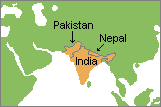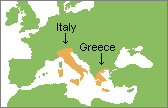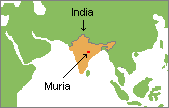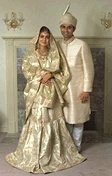Overview: Part I
Marriage is the
socially recognized union of two or more people. Throughout the world, it is an
effective method of regulating heterosexual
![]() intercourse by defining who is socially acceptable as a sexual partner and who is
not. Following marriage, all people, other than one's spouse, are usually defined as off limits for
sexual access. In this way, socially disruptive sexual competition is reduced.
In male dominated societies, these sexual access restrictions often are more
rigorously applied to wives than to husbands.
Marriage also
functions as a glue in the organization of society. It establishes social
relationships that are the foundation for families and households. In
many
societies, it also is an important tool for creating economically and politically valuable
links between families.
intercourse by defining who is socially acceptable as a sexual partner and who is
not. Following marriage, all people, other than one's spouse, are usually defined as off limits for
sexual access. In this way, socially disruptive sexual competition is reduced.
In male dominated societies, these sexual access restrictions often are more
rigorously applied to wives than to husbands.
Marriage also
functions as a glue in the organization of society. It establishes social
relationships that are the foundation for families and households. In
many
societies, it also is an important tool for creating economically and politically valuable
links between families.
Marriage Partner Selection
Selecting a marriage partner is very much a culturally defined process. The rules governing selection vary widely from society to society and are often complex. How would you go about selecting a long-term mate? Where would you begin? What criteria would you use? Would you take the views and wishes of your relatives and friends into consideration?
|
|
|
Padaung woman |
|
When
we look around the world to see how other societies deal with these questions, it is clear
that love and sexual compatibility are not always the basis for selecting a spouse.
However, when romantic love is an important criterion, physical beauty is frequently a key
factor. Age, health, body shape,
and especially facial appearance are usually the focus.
What is considered to be attractive varies considerably from culture to
culture. For instance, if you grew up
in the Padaung
![]() tribal culture of
Thailand, you probably would consider the woman shown on the right with
heavy neck rings
to be unusually desirable.
tribal culture of
Thailand, you probably would consider the woman shown on the right with
heavy neck rings
to be unusually desirable.
It is clear that concepts of beauty are not universal. Some traditional societies of Africa and the South Pacific define large, plump bodies as being attractive, especially for women. Europeans and North Americans today usually define such a body shape as being unhealthy and even ugly. However, ideals of beauty change over time. The slender people shown in the photo on the left below may be an ideal today, but in 18th and19th century Europe, they generally would not have been considered plump enough to be pretty. Renoir's sketch of a woman shown below on the right reflects this preference for plumper bodies.
 |
 |
|
|
Common
North American and European Cultural ideal of beauty |
19th century European preference for heavier female bodies (sketch by Auguste Renoir) |
In China, round "moon-shaped" faces, like the one shown below on the left, have been considered exceptionally beautiful. In contrast, angular Northern European faces, like the one on the right below, have been viewed as being undesirable. Similarly, long-legged Europeans have often been stereotyped as being unattractively stork-like. The Chinese also have traditionally thought that large female feet are ugly. Prior to 1949, rich families sometimes bound the feet of their daughters tightly with cloth wrappings so as to stunt their growth. This of course resulted in severe foot deformities that prevented them from walking normally. However, it made it much easier for them to marry a rich man since they were now more attractive. Over the last two decades, mainland China has rapidly industrialized and developed modern high-rise cities. They have also begun to emulate the life-styles of North America and Europe. This has resulted in a change in middle class concepts of beauty. Taller Chinese men and women are increasingly viewed as being more attractive and successful. Subsequently, there is a thriving business in surgery to increase leg length. It is also becoming popular for women to use makeup and even plastic surgery to acquire more European-like faces.
 |
 |
|
|
Comparison of traditional Chinese and European concepts of beauty |
||
The Chinese are
no more prejudiced about appearance than are people from other parts of the world. Ethnocentric
![]() values universally play an important
part in our perceptions of beauty. However, some psychologists have suggested that
in all societies the essence of beauty is a symmetrical face and body. For instance,
having the same shape eyes equidistant from the center line of the face and at the same
elevation on the head would be universally considered attractive. Individual
cultural differences come into play in favoring particular shapes, sizes, and colors of
eyes. It has been suggested that body asymmetry can indicate
other hidden genetic
abnormalities. If that is the case, preference for symmetry could have evolutionary
advantages.
values universally play an important
part in our perceptions of beauty. However, some psychologists have suggested that
in all societies the essence of beauty is a symmetrical face and body. For instance,
having the same shape eyes equidistant from the center line of the face and at the same
elevation on the head would be universally considered attractive. Individual
cultural differences come into play in favoring particular shapes, sizes, and colors of
eyes. It has been suggested that body asymmetry can indicate
other hidden genetic
abnormalities. If that is the case, preference for symmetry could have evolutionary
advantages.
|
|
|
An
arranged marriage |
|
Personality, education, wealth, and other
individual characteristics also are important mate selection criteria in
many societies. In fact, they may be far more important than physical
beauty. In India, the parents of young
middle class urban women seeking a husband commonly place an add in newspapers. These adds prominently mention the
potential bride's college degrees, caste
![]() , and
implied potential for paying a large dowry
, and
implied potential for paying a large dowry
![]() .
.
|
|
|
Passionate kissing in public |
|
Television, cinema, and other largely Western dominated mass media have been responsible for spreading the notion of romantic love around the world. In previously more isolated nations, such as Nepal, the increasing stress on romantic love has been disruptive of traditional marriage practices in which two brothers marry the same women. The Western version of romantic love fosters the desire for exclusive emotional attachments which undermines marriages in which a spouse must be shared.
Arranged marriages have been common throughout the world. This is due to two principal considerations. First, a marriage unites two families, not just two people. All of a family's members become obligated by the marriage of one of its members. In addition, marriages can be valuable tools in creating alliances and, therefore, must be considered carefully and even negotiated. Secondly, mate selection is seen as being too important a decision to be left up to inexperienced young people, especially if they have had little contact with members of the opposite gender. Parents are presumed to have the experience needed to help their children find a mate who is appropriate for them.
 |
|
In
some nations, the legal system encourages arranged marriages. In Pakistan, for
instance, the law prohibits women from marrying without parental consent. This is
based on Islamic
![]() teachings in the Koran
teachings in the Koran
![]() that
require fathers to protect their daughters. This obligation has been interpreted as
advocating arranged marriages. Specifically, it is seen as a father's duty to find
suitable husbands for his daughters, however, he should not force them into unwanted
marriages.
that
require fathers to protect their daughters. This obligation has been interpreted as
advocating arranged marriages. Specifically, it is seen as a father's duty to find
suitable husbands for his daughters, however, he should not force them into unwanted
marriages.
It is common for people today in the Western World to strongly reject the idea of arranged marriages and to consider them to be barbaric infringements on the "universal human rights" of young adults and especially of women. However, it is useful to suspend our own ethnocentric views on this matter in order to understand why arranged marriages continue to be popular in some societies. In addition to being integral parts of their cultural traditions, arranged marriages are usually seen as being better for the young people getting married and for the community in general because they are thought to result in lasting marriages, and they bring families together. In contrast, basing marriage selection on romantic love alone is often a socially isolating process. The intense romantic focus on one other individual can separate people from their families and friends. It is common for newly married couples in the Western World to set up their own independent household which may be hundreds or even thousands of miles away from family members. This life apart is an appalling prospect for people in traditional societies that practice arranged marriages. It is also an ethnocentric projection to see arranged marriages as being inevitably loveless. In societies that have them, married couples often become loving life-partners. Their marriages set them on a path of discovery to love. In the West, marriage is usually at the end of this path. In both cases, the destination is the same.
Restrictions to
Sexual Access
 |
|
No society allows a person to have complete sexual access to everyone who might be a potential sexual partner. There are always social and legal restraints. In male dominated societies, women are usually expected to be virgins before marriage. They are also expected to mate only with their husbands. There often is an expectation that a woman will remain celibate after her husband dies, regardless of her age. These same rules rarely apply to men. Such a double standard has been a traditional cultural pattern in rural Greece, Italy, and a number of other countries around the Mediterranean Basin.
 |
|
At the other extreme, are societies like the Muria Tribe of Central India. At the age of six, boys and girls traditionally are placed together into a village dormitory by their parents. Through their early teen years, they are encouraged to carry out sexual liaisons with each other to provide them with experiences that will help in selecting compatible marital partners later in life.
All
societies, including the Muria, have incest taboos
![]() . These are rules
prohibiting sexual intercourse with close relatives. While the definition of who is
included in this prohibition varies throughout the world, it generally at
least includes members of one's nuclear family
. These are rules
prohibiting sexual intercourse with close relatives. While the definition of who is
included in this prohibition varies throughout the world, it generally at
least includes members of one's nuclear family
![]() ,
such as parents, brothers, and sisters. Commonly, the taboo extends to
grandparents, some cousins, uncles, aunts,
and may even include more distant relatives.
,
such as parents, brothers, and sisters. Commonly, the taboo extends to
grandparents, some cousins, uncles, aunts,
and may even include more distant relatives.
Societies that have rigid class stratification tend to be more restrictive in terms of sexual experimentation before marriage. As social inequality between the classes increases in such societies, parents become more concerned with preventing their children from marrying "beneath them." Premarital sexual permissiveness is generally prohibited because it might lead to such undesirable attachments. Likewise, the idea of romantic love before marriage is discouraged. However, there are ways of getting around such restrictions in all societies. These include secret liaisons and elopements. Shakespeare's dramatic story of Romeo and Juliet describes just such a case. The two young lovers were forbidden to have contact by their families but they contrived to meet in secret anyway.


